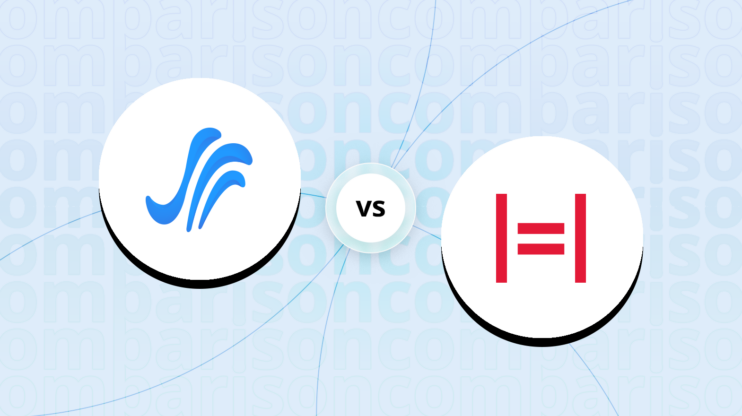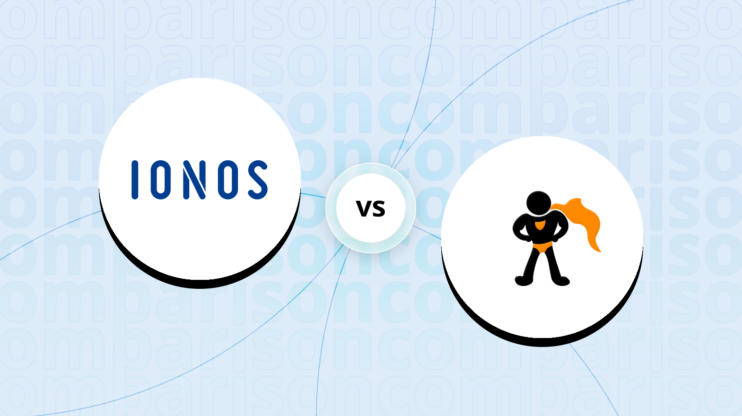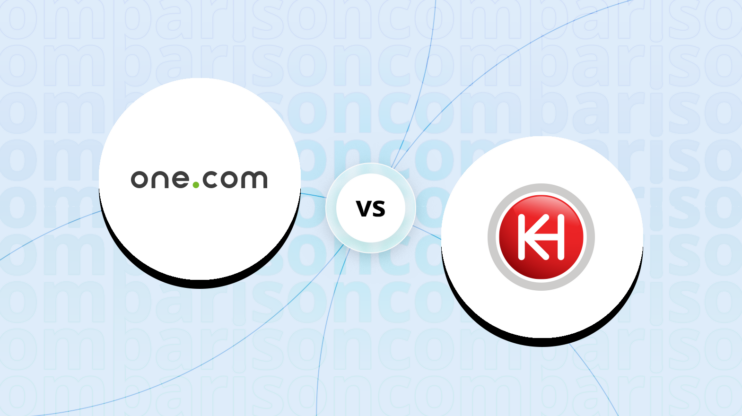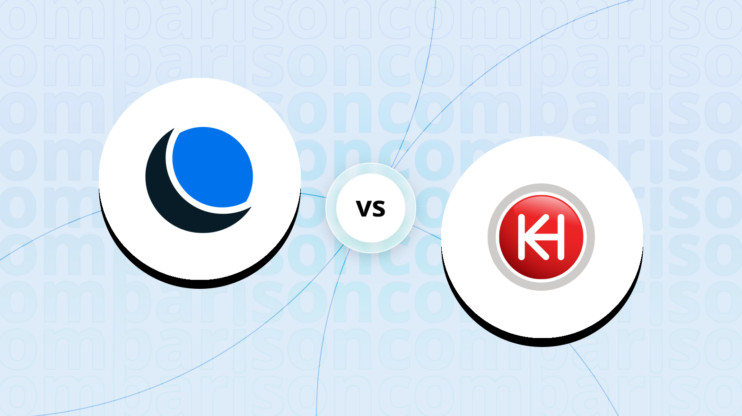Hostinger vs Kinsta: Final verdict
Looking over Hostinger vs. Kinsta, it’s clear why both hosts are so popular. They have both hosted millions of
websites that run on WordPress for decades, building up a loyal customer base.
-
Kinsta (Overall grade: 8.5)
focuses on managed WordPress hosting, known for its outstanding performance, high-level security, and reliability. It leverages Google Cloud’s premium virtual machines, providing superior speed and edge caching that reduces the Time to First Byte by up to 50%. Kinsta’s MyKinsta dashboard is intuitive and packed with features like one-click backups and staging environments, catering well to developers and agencies. Despite these advantages, Kinsta’s higher cost and lack of a built-in website builder may deter some beginner users and those seeking budget-friendly options.
Hostinger (Overall grade: 8.7)
excels with its variety of hosting services, competitive pricing, and user-friendly hPanel. It supports shared, cloud, and VPS hosting, making it versatile for ecommerce, multimedia, and other scalable applications. Hostinger’s key strengths include its intuitive website builder integrated with AI tools, free domain and SSL, and extensive multilingual support. While it provides excellent performance, some users have noted its renewal pricing can be higher. The lack of phone support and certain high-traffic handling capabilities seen in Kinsta may also be limiting for some users.
 Overall grade:8.7 |
 Overall grade:8.5 |
|
|---|---|---|
| Uptime and Availability | 9.2 | 9.7 |
| Hosting Performance | 9.0 | 9.1 |
| Hosting Security | 8.4 | 8.9 |
| Price | 8.8 | 8.8 |
| Hosting Features | 8.3 | 6.7 |
| Ease Of Setup | 9.0 | 9.3 |
| User Management | 8.2 | 7.6 |
| Customer Support | 8.3 | 8.2 |
| User feedback | 4.4/5 | 4.8/5 |
Hosting types offered
Both platforms provide a variety of hosting types, each designed to meet the different needs of users.
 |
 |
|
|---|---|---|
| Shared hosting | ||
| Cloud hosting | ||
| WordPress hosting | ||
| Ecommerce hosting | ||
| VPS hosting | ||
| Dedicated hosting |
Although both offer a variety of hosting plans tailored to different needs, in certain cases, one platform may prove to be more suitable.
Detailed comparison
Uptime and availability
Evaluates the average uptime statistics, uptime guarantee and overall availability of the hosting
provider
Score Components:
- Uptime percentage (30%): evaluates the uptime statistics in given period of time
- Uptime guarantee (20%): Assesses if the platform offers an uptime guarantee and
whether the actual uptime matches the promised guarantee. - General performance (25%): Evaluates how fast is the average response time and overall
it’s stability. - Responsiveness (10%): Adaptability to different devices and screen sizes.
- Availability (25%): Reflects the total downtime and number of outages.
 9.2
9.2
 9.7
9.7
Section 1: Winner Kinsta
Provides top-tier reliability and performance, ensuring 100% uptime in extended tests.
Section 2:
Hostinger offers a 99.9% guaranteed uptime and has demonstrated an average of 99.97% uptime over the past six months. It even maintained a perfect 100% uptime in a 10-week test period. Hostinger’s performance is bolstered by its multiple global data centers that ensure low latency and quick response times, averaging between 450ms and 625ms.
Section 3:
Kinsta not only guarantees a 99.9% uptime but has maintained 100% uptime over a span of numerous tests, including three years of consistent performance. Utilizing Google Cloud Platform and Cloudflare integration, Kinsta ensures fast response times, with an average response time of 461ms. Regular monitoring every three minutes coupled with swift engineer interventions contribute to its impeccable uptime record.
Which one has better hosting performance?
Score Components:
- Hosting speed (30%): This includes SSD quality, Load times, PageSpeed score ranges,
additional information on website speed, built-in plugins for performance enhancement, available caching
methods, and CPU/RAM options - CDN (20%): Considers whether CDN is available or not, whether it’s free or paid, and
the quality of the CDN service - Available data centers (30%): Evaluates the number of data centers and their locations
globally. - Scalibility (20%): Looks at whether elastic scaling is available, the process required
to scale (manual upgrade vs. automatic scaling), the presence of dedicated servers, and the costs
associated with scaling.
 9.0
9.0
 9.1
9.1
🏆 Winner
Kinsta: Superior performance and scalability enhancements.
When comparing the general performance of Hostinger and Kinsta, both offer high-speed CPUs and RAM, promising impressive load times and PageSpeed scores. Hostinger stands out with its LiteSpeed Web Servers and LSCWP Cache Plugin, while Kinsta uses Google Cloud’s premium C2 and C3D virtual machines. Both providers offer CDNs, but Kinsta integrates directly with Cloudflare, adding an extra layer of security and performance. Hostinger boasts global data centers in Europe, Asia, North America, and South America, whereas Kinsta has 35 data centers worldwide, which may offer better global reach.
Website speed
Hostinger prioritizes rapid website loading with its NVMe storage and multiple caching methods, including object caching which drastically reduces response times. Kinsta, leveraging Google’s C2 and C3D virtual machines, offers superior edge caching that cuts Time to First Byte by up to 50%. Hostinger includes AI tools and automatic image optimization to maintain speed, while Kinsta provides continuous MySQL database optimization and built-in Application Performance Monitoring. Both ensure fast and efficient website performance, but Kinsta’s edge caching and built-in monitoring give it a slight edge.
Scalability
In terms of scalability, Hostinger offers a range of cloud-based plans with specified limits that require manual upgrades to scale resources. Their plans include generous storage and bandwidth, but scaling past plan limits isn’t elastic. Kinsta, on the other hand, offers elastic scaling within its managed WordPress, application, and database hosting plans. Pricing for scaling on Kinsta varies by resource usage and plan tier, but the platform does not offer dedicated servers and requires plan adjustments for substantial changes.
Which one has better security features?
and regulatory requirements
Score Components:
- Technical security measures (40%): This includes encryption, firewalls, DDoS
protection, secure configurations, server monitoring, access control and availability of security addons
(e.g Sitelock security). - Operational security measures (30%): Encompasses data privacy, backups and data
redundancy. - Compliance and certifications (20%): Adherence to legal and regulatory requirements
(e.g., GDPR, HIPAA) and possession of certifications (e.g., ISO 27001, SOC 2). - Business and reliability (10%): Factors in the provider’s reputation, uptime
guarantees, and customer support.
 8.4
8.4
 8.9
8.9
🏆 Winner Kinsta: A web hosting service providing robust security measures ideal for WordPress websites.
Both Hostinger and Kinsta, have notable differences in their approaches to technical and operational security, as well as in their compliance with regulations.
Technical security measures:
Hostinger offers comprehensive technical security measures including 24/7 server monitoring, firewall protection, advanced security modules, and anti-malware protection. Consistent security configurations and continuous vulnerability scans bolster their defenses. Kinsta matches with managed WAF, DDoS protection, multiple backup options, proactive site monitoring, and free malware removal services. Both providers offer PHP version control, but Kinsta includes custom and wildcard SSL certificates, enhancing its security offering further.
Operational security measures:
Hostinger has a dedicated internal security team, internal policies and procedures, and follows OWASP secure coding practices. Two-factor authentication (2FA) is mandatory on all applicable systems. Kinsta pledges to repair malware damage on WordPress sites and provides security vulnerability alerts, SSH or SFTP access with WP-CLI support, and application performance monitoring. Hostinger follows industry-standard policies but lacks Kinsta’s proactive security pledge and monitoring depth.
Compliance and certifications:
Hostinger is GDPR compliant but does not offer HIPAA or PCI-compliant environments, nor does it hold ISO or SOC certifications. Kinsta is GDPR and SOC 2 compliant, ensuring enterprise-grade security. PCI compliance details are not specified, but the robust security infrastructure can aid in achieving it.
 |
 |
|
|---|---|---|
SSL certificate |
Free |
Free, Custom, Wildcard |
Additional security features |
Malware scanner, DDoS protection, WHOIS privacy |
Edge caching, malware removal, IP deny tool |
PHP versions |
Version control |
PHP version selector |
GDPR compliance |
Yes |
Yes |
HIPAA compliance |
Not intended |
Not specified |
PCI compliance |
Not intended |
Not specified |
Hosting features
Score Components:
- Domains (20%): Assesses the availability of a free domain, domain purchase options, and
pricing - Email (15%): Considers if the provider offers full email hosting, or is reselling
third-party service, and if the email is only transactional or not - Website builder (15%): Checks if website builder is available, and it’s user
friendliness and overall the level of customization allowed. - Staging environment (20%): Determines if a staging environment is available, allowing
for testing changes before going live. - FTP & SFTP accounts (10%): Evaluates if and how easily users can access FTP and
SFTP accounts - Git and SSH access (20%): Assess whether Git is integrated into the hosting service and
if SSH access is provided
 8.3
8.3
 6.7
6.7
🏆 Winner Hostinger: A reliable and feature-rich hosting provider suitable for a wide range of users.
Hostinger offers a versatile hosting experience with its custom-built hPanel control panel, making it user-friendly for both beginners and professionals. One of its standout features is the intuitive drag-and-drop website builder that incorporates AI tools to assist in website creation. Hostinger provides a free domain and SSL, which are significant advantages for cost-conscious users. The advanced security measures, including Imunify360 and Cloudflare DNS Firewall protection, ensure that your website remains secure. Additionally, Hostinger’s 24/7 multilingual support via live chat or email is a clear benefit for users who need continuous assistance.
Kinsta, on the other hand, is known for its specialized managed WordPress hosting. While it doesn’t offer a website builder, its focus on performance and high-level security measures makes it ideal for users who require a robust hosting environment. Kinsta provides detailed FTP/SFTP and SSH access information for more tech-savvy users. However, the absence of a built-in website builder might be a limitation for beginners. Their unique pricing model and the need to use third-party email services like Google Workspace could be points of consideration for potential customers.
 |
 |
|
|---|---|---|
Free domain |
Yes |
No |
Free SSL |
Yes |
Yes |
Email hosting |
Yes |
No, requires third-party |
Website builder |
Yes |
No |
Staging environment |
Yes |
Yes |
FTP & SFTP account |
Yes |
Yes |
Git and SSH access |
Yes |
Yes |
Free backup |
Yes |
Yes |
Money back guarantee |
Yes |
Yes, 30 days |
a location.
As a result in rare cases the features mentioned here can differ from the ones you see on their websites.
Both providers support a range of users from beginners to experts with user-friendly website builders and WordPress staging areas. However, in terms of developer tools, both Hostinger and Kinsta offer robust options including SSH access, support for multiple programming languages, and Git for version control, thus appealing to developers looking for advanced capabilities.
Email services:
Hostinger includes email hosting as part of its plans, which allows users to set up and manage their own email campaigns. This integrated approach can be convenient for users who require a single solution for both their website and email needs. Kinsta, in contrast, does not offer its own email hosting but supports third-party services like Google Workspace and Zoho. This means users will need to subscribe to an additional service for email, which could entail extra costs but also provides more flexibility in selecting the email service that best suits their needs.
Price
Score Components:
- Plan value (40%): What each pricing tier offers.
- Transparency and clarity (30%): Clearness of pricing structures.
- Flexibility of plans (20%): Range of options to suit different budgets.
- Hidden costs (10%): Additional expenses not included in the plan.
 8.8
8.8
 8.8
8.8
🏆 Winner Hostinger: A versatile hosting provider offering a range of affordable plans with extensive features.
Evaluating the pricing of plans among various hosting providers can be complex due to their differing pricing and renewal strategies. Additionally, certain plans require annual commitments, which adds to the difficulty of making comparisons. The prices listed are based on monthly commitments; plans requiring annual commitments are indicated. Additionally, although some providers offer identical plans for WordPress and shared hosting, we have created separate tables for each to enhance clarity.
Hostinger offers a variety of plans across different hosting categories, including shared, cloud, and WordPress hosting, with competitive introductory prices and extensive features. In comparison, Kinsta focuses on managed WordPress and various application hosting plans that come at a higher monthly cost with a premium focus on performance and support. Hostinger’s shared hosting plans, such as their Premium Web Hosting at $7.99/month, deliver excellent value with unlimited bandwidth and free SSL certificates, making them highly cost-effective. Kinsta’s starting price for managed WordPress hosting is significantly higher at $35/month, offering premium features like extensive CDN and backup retention. Hostinger’s more budget-friendly approach, combined with value-rich features, makes it a strong contender for both beginners and advanced users.
 |
 |
|---|---|
|
Single Hosting $3.99
1 website, 50 GB SSD, 100 GB bandwidth, 1 email, free SSL, weekly backups, managed WordPress, 24/7 support. Value for price:9.0
|
Starter Plan $30 monthly
1 website, 10GB storage, 100GB CDN, 25,000 monthly visits. 14-day backup retention. Value for price:7.5
|
|
Business $8.99
100 websites, 200 GB NVMe storage, unlimited bandwidth, free email, daily and on-demand backups, priority support. Value for price:9.5
|
N/A
Value for price:N/A
|
 |
 |
|---|---|
|
Premium $7.99
Custom domain, 100 domain-based emails, WordPress themes, 100 subdomains. Value for price:9.0
|
Starter Plan $30 monthly
1 website, 10GB storage, 100GB CDN, 25,000 monthly visits. 14-day backup retention. Value for price:7.5
|
|
Business $8.99
Custom domain, 100 domain-based emails, WordPress themes, 100 subdomains. Value for price:9.5
|
Business 1 $96 monthly
5 websites, 30GB storage, 400GB CDN, 100,000 monthly visits, 14-day backup retention. Value for price:7.0
|
|
Cloud Startup $19.99
Custom domain, 300 websites, WordPress multisite, 100 domain-based emails, 200,000 monthly visits. 200 GB NVMe storage. Value for price:9.5
|
Business 2 $188 monthly
10 websites, 40GB storage, 600GB CDN, 250,000 monthly visits, 14-day backup retention. Value for price:7.0
|
 |
 |
|---|---|
|
Cloud Startup $19.99
300 websites, 200,000 monthly visits, 200 GB NVMe storage. Unlimited bandwidth, daily and on-demand backups. Value for price:9.5
|
Standard 1 $20 monthly
0.5 CPU, 1GB RAM, flexible monthly pricing. Value for price:7.0
|
|
Cloud Professional $32.99
300 websites, 250 GB NVMe storage. 6 GB RAM, 4 CPU cores, unlimited bandwidth, daily backups. Value for price:9.5
|
Standard 2 $40 monthly
1 CPU, 2GB RAM, flexible monthly pricing. Value for price:7.0
|
|
Cloud Enterprise $54.99
300 websites, 300 GB NVMe storage. 12 GB RAM, 6 CPU cores, unlimited bandwidth, daily backups. Value for price:9.5
|
N/A
Value for price:N/A
|
Enterprise plans
Hostinger’s Cloud Enterprise plan, priced at $54.99/month, offers comprehensive features suitable for demanding enterprise environments, including 12 GB RAM, 300 GB NVMe storage, and 6 CPU cores. The plan covers 300 websites with unlimited bandwidth and daily backups. In contrast, Kinsta’s Business 4 plan, starting at $375/month, supports 40 WordPress installs, 600,000 monthly visits, and includes advanced features like extensive CDN and up to 20 days of backup retention. For larger enterprises needing 1,000,000+ visits, Kinsta’s enterprise plans start from $675/month, providing over 60 WordPress installs, 2,000+ GB CDN, and a 30-day backup retention policy.
Hostinger vs Kinsta: Ease of setup
platform.
Score Components:
- Site migration (25%): Assesses whether the provider offers tools for site migration,
either automated or manual, and whether these services are free or require a fee. - Admin panel usability (35%): Evaluates the type of admin panel provided, such as the
standard cPanel or a custom solution, focusing on its accessibility and user-friendliness for both
technical and non-technical users. - Setup features (20%): Examines the availability and ease of use of various setup
features, including FTP accounts, file managers, email account setup, PHPMyAdmin, and easy CDN
configuration. - Help center quality (20%): Measures the quality and accessibility of the provider’s
help center resources, including articles and tutorials.
 9.0
9.0
 9.3
9.3
🏆 Winner
Kinsta: A comprehensive hosting solution with a user-friendly dashboard and extensive support resources.
Hostinger provides an intuitive control panel called hPanel, designed for user-friendliness and accessibility. hPanel simplifies tasks such as setting up email, installing CMS, and building websites without needing technical expertise. The control panel also integrates artificial intelligence tools that help expedite content creation and automate updates.
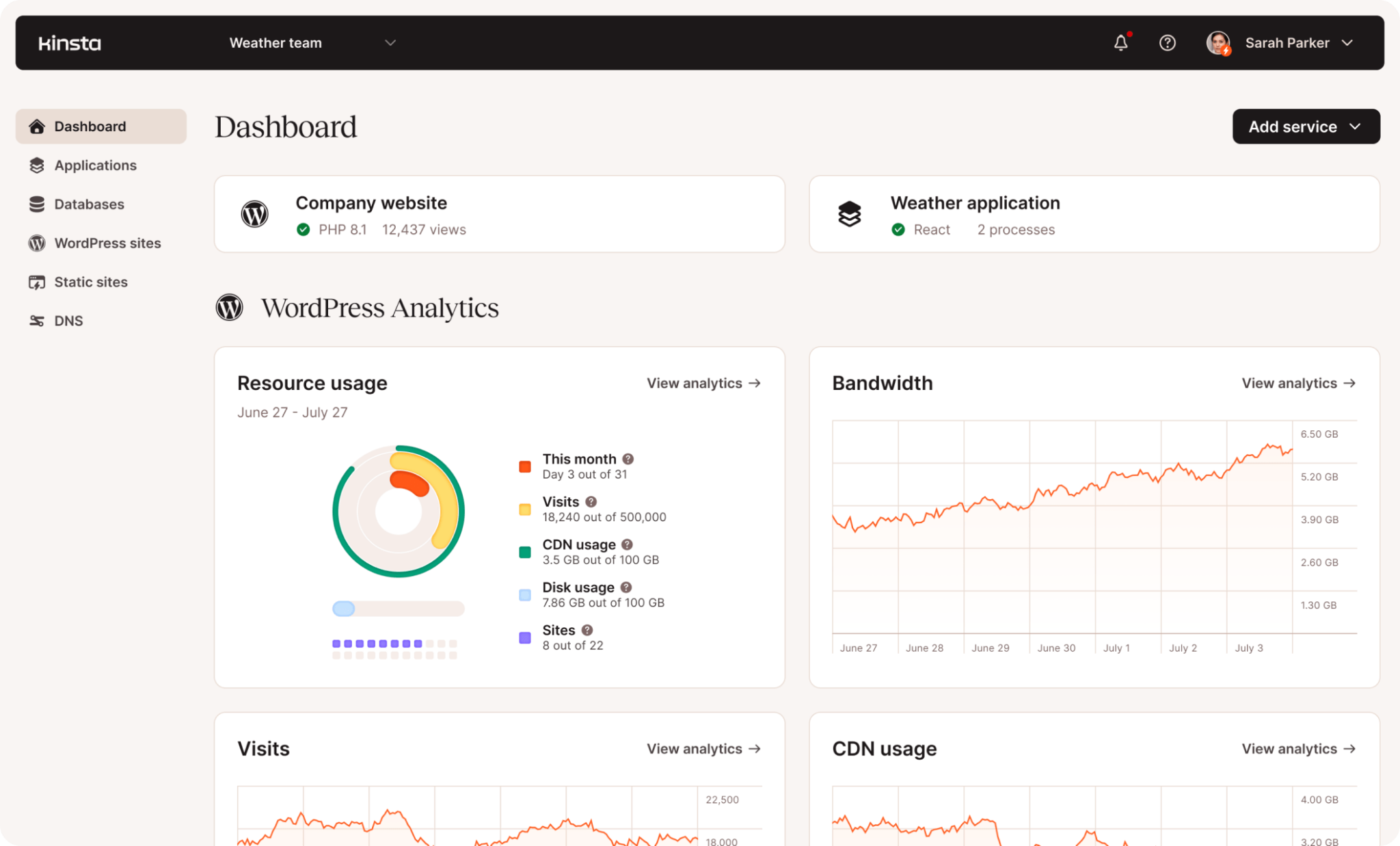
Kinsta, on the other hand, boasts the MyKinsta dashboard, an award-winning, custom-built solution known for streamlining site management. It includes one-click backup creation, easy cache management, and simple PHP version selection. Additionally, Kinsta offers staging environments, catering both beginners and professionals.
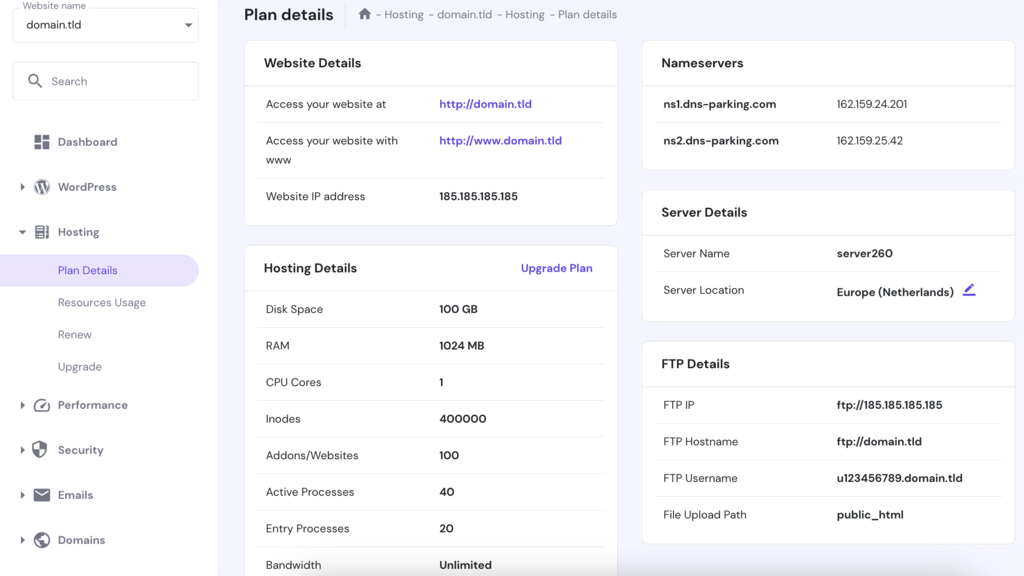
Both Hostinger and Kinsta provide free migration services. Hostinger’s migration is automatic, ensuring no downtime during the process. Kinsta offers a straightforward migration via the MyKinsta dashboard, with both basic and premium migration options, guided by detailed steps and support.
The platforms provide extensive knowledge bases filled with guides, how-to articles, and instructional content. Hostinger offers a wide range of resources alongside 24/7 chat and phone support. Kinsta also boasts a detailed help center with an intuitive search function and around-the-clock support via live chat, phone, and ticketing, ensuring comprehensive user support.
User management
accessibility.
Score Components:
- Role customization (40%): Flexibility in creating and defining user roles and
permissions. - Ease of management (30%): User interface and tools for managing users.
- Access control (20%): Effectiveness of access control measures for different user
levels. - Scalability (10%): Ability to manage a growing number of users efficiently.
 8.2
8.2
 7.6
7.6
🏆 Winner
Hostinger: Provides a seamless user management experience with a variety of access controls and onboarding features.
Hostinger and Kinsta offer distinct competencies in managing user roles, permissions, and accessibility. Hostinger allows for effortless client onboarding with just a few clicks and centralized service management, giving administrators complete oversight. In contrast, Kinsta emphasizes the customer’s responsibility to manage their user accounts and ascertain the correct access levels for company use, providing Two-Factor Authentication (2FA) for added security. Hostinger’s strength lies in its detailed access levels, where different roles have specific responsibilities. Conversely, Kinsta assigns broad responsibilities to company owners, administrators, and developers, expecting them to manage permissions diligently.
Hostinger’s hPanel features are intuitive, with clearly defined paths to add new clients and manage websites and domains. The interface offers functionalities like viewing website titles, hosting plans, and accessing the WordPress admin panel directly from the dashboard. The process for account sharing and determining access levels is streamlined. Kinsta’s MyKinsta portal focuses more on customer-managed access but provides a secure environment through 2FA and simplified user settings. However, the interface demands familiarity with the platform’s tools, especially for managing site content, plugins, and access roles.
For access control and managing a growing number of users, Hostinger excels with its specified access levels and restrictions, ensuring secure and efficient oversight. Users can manage services, make purchases, and handle website performance scores through a centralized system, which enhances workflow efficiency. Kinsta’s approach, delegating responsibilities to users for correct access levels and content management, ensures user autonomy but may require more vigilance from administrators to avoid mismanagement. Both platforms provide security; however, Hostinger’s more structured access control appears more effective for handling numerous clients.
Hostinger user roles table:
| Role | Description | Access highlights |
|---|---|---|
| Manage services | Modify files, websites, manage VPS, change hosting settings | Allows website management, VPS adjustments |
| Manage services and make purchases | Includes all “Manage services” capabilities plus purchasing power | Can manage services and buy new plans or domains |
Kinsta user roles table:
| Role | Description | Access highlights |
|---|---|---|
| Company Owners | Full access, including adding/removing users | All company and site management, user access control |
| Company Administrators | Broad admin rights, similar to Company Owners | Administrative functions, adding/removing users |
| Company Developers | Technical oversight, primarily for development purposes | View users, grant access to WordPress sites |
Customer support
hosting provider.
Score Components:
- Support communication channels (30%): Measures the variety of customer support types
provided (live chat, chatbot, email, phone, etc.) - Availability (20%): Assesses the availability hours for each channel, including 24/7
support options. - Technical support quality (30%): Assesses whether the provider offers comprehensive
technical support, including hardware upgrades (e.g., HDD to SSD), software installations, and web
server configuration changes. - Enterprise support (20%): Checks if there are dedicated or priority support services
for enterprise-level customers.
 8.3
8.3
 8.2
8.2
🏆 Winner Hostinger: Hostinger offers a comprehensive range of customer support options alongside impressive response times.
 |
 |
|
|---|---|---|
Phone Support |
||
Live Chat Support |
||
Chatbot |
||
Email/Ticket Support |
||
Enterprise Support (dedicated agent, priority support) |

Hostinger and Kinsta both present strong customer support options, each catering to different needs. Hostinger offers 24/7 live chat support directly through your account dashboard and extends multilingual support across more than 10 languages. Kinsta, meanwhile, provides 24/7 live chat support for paid customers through their MyKinsta dashboard and an average response time of under 2 minutes, adding proactive site monitoring every 3 minutes.
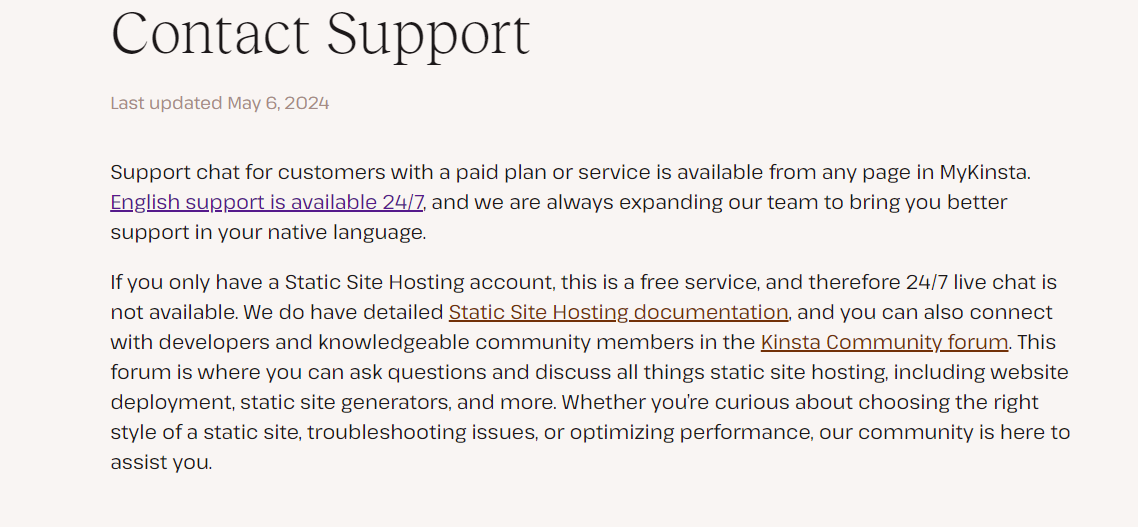
Both companies have extensive knowledge bases available online, though Hostinger further enhances customer assistance with its Hostinger Academy offering video tutorials. Hostinger’s email support covers a range of issues from general inquiries to abuse reports and account recovery, while Kinsta offers phone support for sales and uses a human-only expert support model without AI or chatbots. Both companies offer enterprise support options, but Hostinger’s multilingual and faster response services slightly edge it out as the preferred choice for versatile, reliable customer support.
Hostinger vs Kinsta: User feedback
Hostinger receives high praise for its user-friendly interface, competitive pricing, and robust performance. Customers appreciate the wide range of features, including seamless website migration, the intuitive hPanel, and excellent uptime. The standout feature, consistently mentioned across reviews, is the exceptional and responsive customer support available 24/7 via live chat, although some users express a desire for phone support. On the downside, a few customers report issues with renewal pricing, occasional slow support response times, and the limitations of the lower-tier plans.
Kinsta is highly recommended by users for its reliable and easy-to-use hosting services, particularly for WordPress sites. Customers appreciate the fast and responsive customer support, impressive speed, and robust security features provided by the platform. The user-friendly dashboard and extensive documentation also stand out as significant advantages, making it easy for both novices and tech-savvy individuals to manage their sites. However, some users find the pricing to be on the higher side, and a few have suggested improvements like expanding data center locations and providing direct access to all integrated services. Overall, Kinsta is praised for delivering a high-quality, dependable hosting experience.
Hostinger vs Kinsta: FAQ
Which platform is better suited for hosting WordPress websites?
Kinsta is better suited for hosting WordPress websites, offering high-performance infrastructure, enterprise-grade security, and advanced WordPress tools. It provides features like edge caching and Google Cloud’s premium virtual machines to ensure superior speed and reliability. Hostinger also supports WordPress hosting, but Kinsta’s specialized focus on WordPress makes it the more suitable option.
Which hosting service offers better security features?
Both Hostinger and Kinsta offer robust security features, but Kinsta edges out slightly with its managed WAF, DDoS protection, malware removal services, and custom SSL certificates. Hostinger provides advanced security modules, anti-malware protection, and Imunify360. However, Kinsta’s proactive security measures, including continuous vulnerability scans and proactive monitoring, give it a slight advantage.
What are the major differences in pricing and value between hostinger and kinsta?
Hostinger offers more budget-friendly hosting plans with extensive features such as a free domain, free SSL, and generous storage options, making it an attractive option for cost-conscious users. Kinsta’s plans are more expensive, starting at $30/month, but they include premium features like extensive CDN, superior speed, and reliable performance. Hostinger is better for those seeking affordability, while Kinsta caters to users needing high performance and robust support.
Which hosting service offers more scalability options for growing websites?
Kinsta provides more elastic scaling within its managed WordPress and application hosting plans, allowing for easy adjustments based on resource usage. Hostinger offers cloud-based plans with specified limits, requiring manual upgrades for scaling resources. While Hostinger’s plans are cost-effective and generous, Kinsta’s elastic and automatic scaling options make it more suitable for rapidly growing websites.
Which platform offers better customer support?
Hostinger and Kinsta both offer comprehensive customer support, but Hostinger provides multilingual support across more than 10 languages, available 24/7 via live chat and email. Kinsta also offers 24/7 live chat with average response times under 2 minutes and phone support for sales. Hostinger’s faster response times and multilingual support give it a slight edge in customer assistance.
The making of this blog
We followed a clear, step-by-step process to write and research this article.










